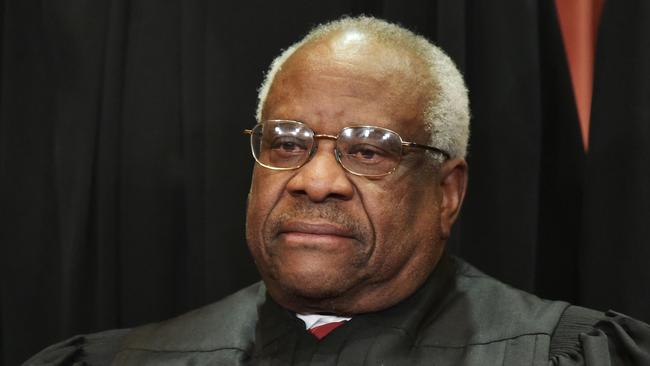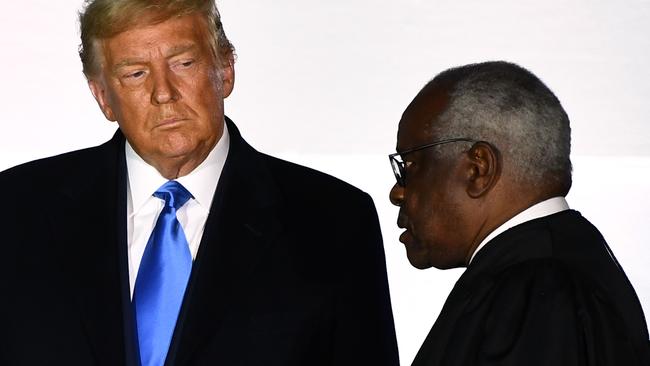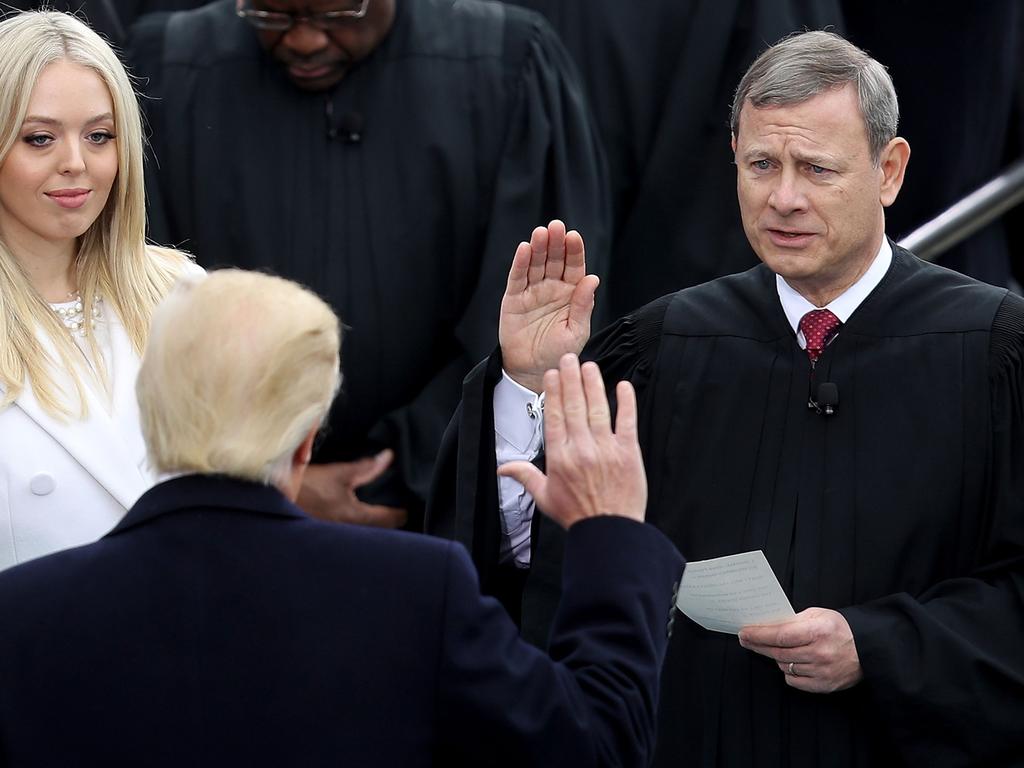Threats, racist abuse … how Clarence Thomas became America’s most hated man
Not only did Clarence Thomas join in the majority decision that threw out Roe v Wade, he took aim at other rights granted by the court.

Five justices of the Supreme Court overturned the landmark Roe v Wade ruling that provided American women with the constitutional right to an abortion, but none has aroused the ire of Democrats and pro-abortion activists as much as the court’s only, until recently, black judge, Clarence Thomas.
The veteran conservative judge has become the most hated man in America in progressive circles since Friday’s historic decision, which returned the rights to make rules on abortion back to the 50 US states and unleashed a wave of protest across the nation.
Not only did Thomas join in the majority decision that threw out Roe v Wade, the totemic 1973 ruling that provided women across the US with a right to an abortion, he took aim at other cherished rights granted by the court, which the other justices specifically said should remain untouched.
“Because any substantive due process decision is ‘demonstrably erroneous,’ we have a duty to ‘correct the error’ established in those precedents,” Thomas wrote, specifically referring to Supreme Court cases in 1965, 2003 and 2015, which granted Americans rights to use contraception, same-sex intimacy, and same-sex marriage, respectively.
As protests erupted in California, South Carolina, Oregon and Rhode Island over the weekend, protesters descended on the homes of the conservative justices, their addresses widely distributed by left-wing activist groups, outside Washington DC, one waiving placard calling Thomas a “treasonous turd”.
“I’ve been really shocked by the number of progressives calling Clarence Thomas a “nigger” because of his stance on abortion,” said professor Anthony Bradley on social media, himself black man, at King’s College, New York City.

Social media has lit up with thousands of unprintable threats and racist abuse towards the judge since Friday’s verdict.
“Twitter allowing straight up racist attacks on Clarence Thomas to trend,” said Andrew Surabian, a political strategist, pointing out that “Uncle Clarence” was trending on Twitter. Actor Samuel L Jackson had also made the reference, an allusion to black man servile towards whites from the 1852 novel Uncle Tom’s Cabin, on Friday.
Congress passed a law to improve security for the Supreme Court justices earlier this month, after a man with a gun, who said he planned to kill one of the conservative judges, Brett Kavanagh, was arrested outside the judge’s home following an earlier leak of the Roe decision to the media.
Thomas, who grew up in poverty in Savannah, Georgia, before attending Yale Law School in the early 1970s, has frustrated progressives ever since his nomination to the top court by George H Bush in 1991, routinely criticising affirmative action.
“Perhaps some are confused because they have stereotypes of how blacks should be and I respectfully decline, as I did in my youth, to sacrifice who I am for who they think I should be”, he wrote in 2002.
Last week Thomas penned the majority opinion in another controversial verdict, which struck out a 109-year old New York state law that had restricted the right to carry handguns outside the home, citing Americans’ second amendment rights to bear arms.

Meanwhile, the January 6th committee, in the middle of a series of public hearings into Donald Trump’s role in last year’s riots on Capitol Hill, has demanded an interview with Judge Thomas’s wife, Ginni, a conservative activist who had been in communication with senior Trump advisers at the time.
Naturally, on the right side of American politics, Thomas is lionised as a brilliant, captivating jurist, an iconic success story of whom all black Americans in particular should be proud.
But the animosity towards the judges, especially Thomas, foreshadows a difficult time for the nation’s highest court, whose favourability rating among the US public had already declined from 69 per cent in August 2019 to 54 per cent in January, according to Pew Research.
“This court has lost legitimacy,” Democrat Senator Elizabeth Warren said on Sunday, reflecting a growing fury among the ruling party’s far-left wing.
“They have burned whatever legitimacy they may still have had, after their gun decision, after their voting decision, after their union decision. They just took the last of it and set a torch to it with the Roe vs. Wade opinion.”
President Biden’s appointment of Ketanji Brown Jackson, who has become the first black female supreme court justice, didn’t change the equation: she replaced outgoing progressive justice Stephen Breyer.

The court’s recent decisions reflect Democrats’ worst fears. Donald Trump might be gone, but the US is facing a decade at least of conservative rulings. Thomas, the oldest judge, is a sprightly 74, in a court where judges typically serve well into their 80s.
The perceived politicisation of the court belies the congenial atmosphere among the judges. Thomas and the late supreme court justice Ruth Bader Ginsburg, then the court’s most progressive justice, were friends.
Justice Sonia Sotomayor, one of the three justices who dissented in overturning Roe, last week said in a public address said she “probably disagreed with [Clarence Thomas] more than with any other justice”, but still got on with him well.
“He is the one justice in the building who literally knows every employee’s name … He is a man who cares deeply about the court as an institution, about the people who work there,” Sotomayor said.
Friendly relations among the judges may prove small mercies. The court is facing its most challenging few years since Roosevelt schemed to ‘pack the court’ with favourable judges in the late 1930s.







